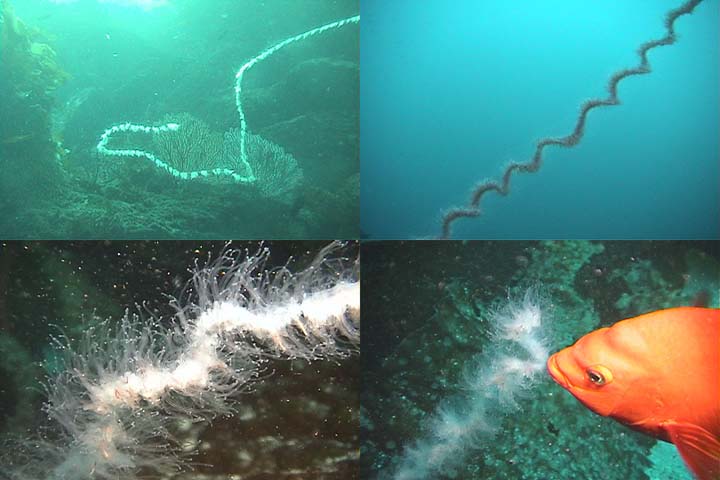DIVE DRY WITH DR. BILL #189: The "Frayed Rope" Siphonophore
While heading towards the boulder reef at Torqua Springs last February with my Korean dive buddy Amy, I encountered what looked, from a distance, like a 15-20' section of frayed rope. In this ocean of "weekend warriors," we know all too well that their vessels may cast off pieces of rope, anchors and chains, stainless steel barbecues, diamond rings and even the entire boat itself. This is one of the reasons we have the annual Avalon Harbor Cleanup sponsored by the Catalina Conservancy Divers and the Chamber at Two Harbors.
However, as I drew closer, I quickly realized its true identity. This was not a frayed rope, but the largest piece I've ever discovered of a marine critter I've never seen in its entirety. What gave it away were the many thousands of nearly transparent polyps that formed the "frayed" part of this "rope." It was part of the siphonophore known as Apolemia, a relative of the sometimes deadly Portuguese man-of-war. Some have referred to the local species as Apolemia uvaria, but it is now believed this species is limited to the North Atlantic and Mediterranean Sea. Actually there are some 15 species of Apolemia here in California, so I'm not sure which one I encountered. Since it has no common name that I'm familiar with, I'll just give it one... the frayed rope siphonophore! Finally I've given a name to a marine critter.
When it is intact, this species lives out in the open ocean. It is said it may reach lengths of 30 meters (about 100 ft). Near shore I only encounter the bits and pieces that break off of them, usually no more than 1-2' in length. In fact many members of this group are known only from their broken strands since few intact individuals are observed or collected. This was an exceptional fragment. Like their jellyfish relatives, these Cnidarians have stinging nematocysts. I do not know if this species carries a powerful sting so I have avoided direct contact with them. I remember when I was growing up in northern Florida, Mom was stung by their man-of-war relative and it was quite painful.
Entire specimens have a gas-filled float called a pneumatophore and a series of swimming "bells" known as nectophores. You don't need to memorize those terms... I promise there will be no quiz next week. The swimming "bells" trail the long stems carrying the feeding and reproductive structures or polyps. It is pieces of these structures that I occasionally see near the kelp forests after they have broken off and drifted inshore. Although some have viewed these critters as colonies of individuals, current thinking is that they are single animals.
Despite their huge size, these siphonophores are members of the plankton. They drift in the open ocean currents, although winds may also cause them to "sail." Siphonophores will spread out their long trailing stems to form net-like structures capable of capturing food. I guess this is somewhat akin to deploying a drift net. I have read that their toxin can kill even large fish, so it is a good thing I've never touched one. Due to my gills, it might think I'm potential prey!
So far I have discovered only one image of what appears to be an entire Apolemia. It was photographed by the Monterey Bay Aquarium Research Institute (MBARI) using a submerged ROV (Remotely Operated Vehicle). It was observed off Hawaii, so I don't even know if the species they noted is the same as the one I have here. Bioluminescence refers to the emission of light by organisms through chemical means like that used by fireflies and other critters. Scientific studies of bioluminescence in plankton show that these siphonophores emit light, mostly in the blue range. The significance of this light emission could be to signal other members of the species or attract prey into their feeding net. Sounds a little like the lights used by squid boats to attract their catch.

Image caption: The long strand of the "frayed rope" siphonophore, its coil like detail; a close-up
showing the individual polyps and a garibaldi with a taste for spicy food.

Image caption: The swimming bell and polyp strand of a living Apolemia













